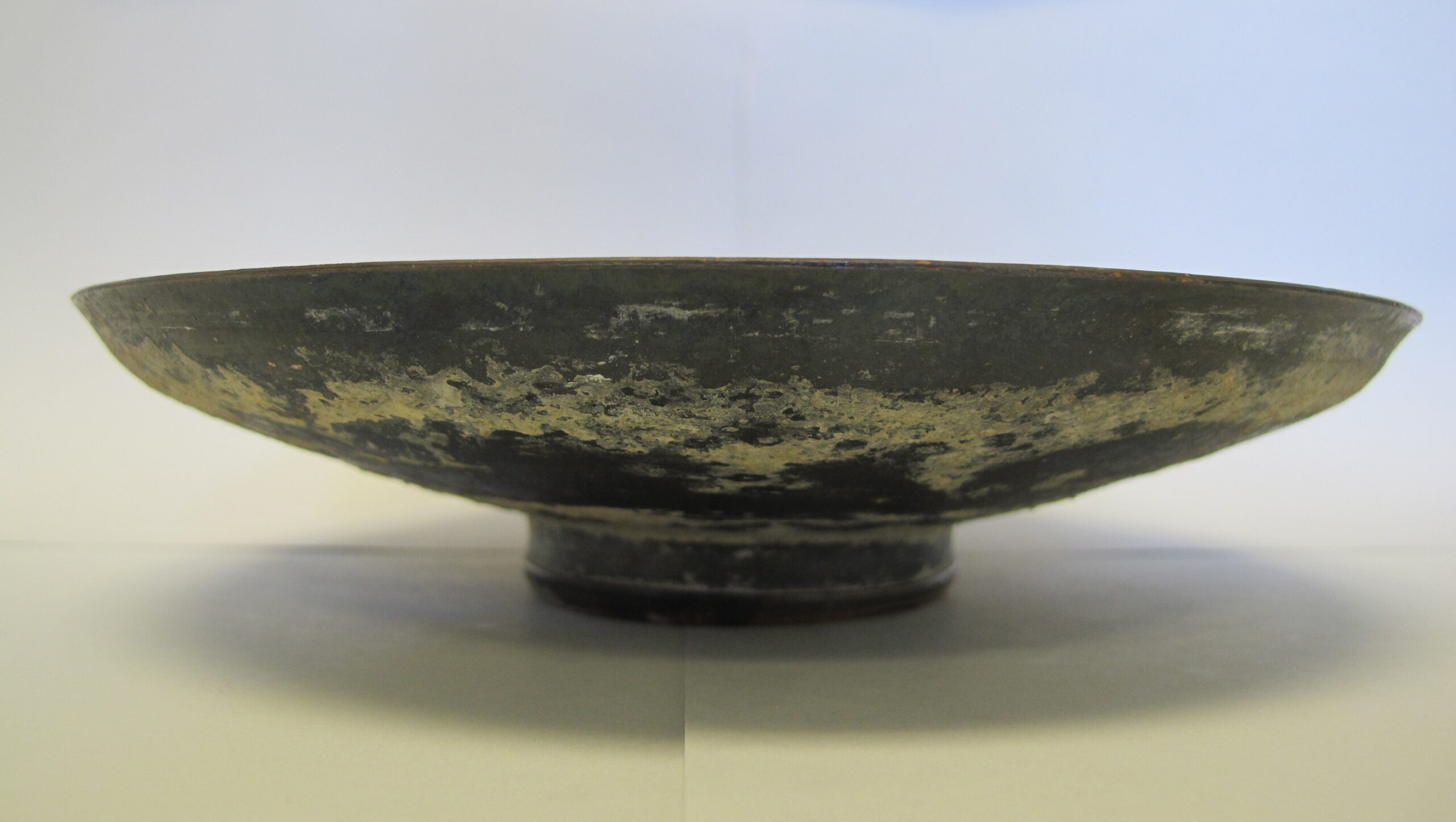AWG0000.03.06
Etruscan
Hellenistic period (3rd century BCE)
Material: Ceramic
Technique: Black-glazed
Weight: 213g
Dimensions: 4cm high, base diameter 6.5cm, max. diameter 18cm
Condition: Good condition, very small chip on inside of base, encrusted with mineral deposit on about 40% of the surface area
Provenance: Unknown
Source/donor: Unknown
Date of acquisition: Unknown
Research by: Hunter Hagan, ’22
Detailed description of form/shape:
Shallow, circular saucer/plate that curves up slightly as it rises to a smooth, flat rim. Low, vertical ring foot base.
Detailed description of decoration:
Reddish-orange clay coated in a metallic grey-black slip made using finer clay to produce dark exterior when fired. The entire saucer, apart from the bottom of the foot, is covered by the black slip. On the flat interior floor of the plate, there is a circular area of lighter gray color. There is also a seam in the slip around the bottom of the plate about halfway between the base and the rim.
Comparanda:
Very similar in shape and decoration are two bowls in the Penn Museum MS1476 and MS1480, both from Tosconalla and dated to the late 3rd century. For the vessel shape, compare also Stone figs. 5, 5B, and 6, from Morgantina figs. 267B and 268A, and Rotroff pl. 42 figure 315, from the Athenian Agora. For the most comparable flat topped lip shape, see Stone pl. 30, fig. 186A . For a similar shape and style, although including designs on the top surface, see White and Horne, 74-75.
Discussion:
Likely used for small servings of food, small black-glazed dishes like this became very popular in the Hellenistic period, especially in the late 3rd century. Despite the mineral encrustation that covers much of this dish, its beautiful craftwork can be appreciated: the surface is smooth and seamlessly transitions from the flat rim to smooth underside, and the metallic black slip evokes the appearance of silver. The dish also gives insights into the production process. The lighter color in the center of the interior results from stacking in the kiln – known as a ‘stacking circle,’ the area corresponds to the ring foot of another dish stacked above it during the firing process. The ‘seam’ around the bottom likely represents where one application of the slip ended and the next started.
On the surface of the plate are three spots of dark staining on the glaze. These spots appear to be a form of rust and may point to a metal object resting on top for an extended period of time. Although the provenance of this object has been lost and it is unknown what exactly caused the rust and encrustation on the saucer, it was likely resting in the ground with a metal utensil or other object for a significant period.
Bibliography:
“Bowl MS 1476.” Collections - Penn Museum, April 21, 2021. https://www.penn.museum/collections/object/214359.
“Bowl MS 1480.” Collections - Penn Museum, April 21, 2021. https://www.penn.museum/collections/object/66294.
Rotroff, Susan I. Hellenistic Pottery: The Plain Wares. The Athenian Agora, vol. 33. Princeton: American School of Classical Studies, Athens, 2006). http://www.jstor.org/stable/25481903.
Stone, Shelley C. Morgantina Studies, Volume VI: The Hellenistic and Roman Fine Pottery. Princeton, NJ: Princeton University Press, 2015.
White, Donald, and Lee Horne. Guide to the Etruscan and Roman Worlds at the University of Pennsylvania Museum of Archaeology and Anthropology. Philadelphia, PA: University of Pennsylvania Museum of Archaeology and Anthropology, 2002.



